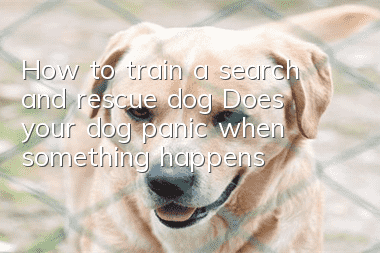How to train a search and rescue dog? Does your dog panic when something happens?

Train search and rescue dogs to develop conditioned reflexes towards bloody smelling objects
The trainer should first identify a certain ruin and throw two objects with bloody smelling objects 20 meters apart. At different locations outside the area, after pausing for a moment, give the dog the "search" command and make gestures to guide the dog to search one by one. When the dog finds the first object, reward (feed) the dog immediately, and continue to direct the dog to search for the second object. This training needs to be repeated several times.
When the dog can actively search for objects with a bloody smell, you can bury two to three blood-stained objects in the ruins in advance, and then use fake delivery or throwing methods to induce the dog to search. After repeated After training, the dog can form a conditioned reflex to the "search" command and gesture.
After that, the blood volume can be reduced, the size of the object can be reduced, and the search difficulty can be increased. As the reflective ability gradually improves, the search range increases and the distance between people and dogs increases. Make the dog gradually transition from grasping behavior to barking alarm behavior after discovering the object. At the same time, it is necessary to cultivate the dynamic shaping ability of dogs in shuttle search.
Cultivate search and rescue dogs’ aerial search and barking alarm capabilities
On the basis of shuttle search training for ruins, continue to expand the search area and scope, and increase the placement of blood-stained items The spacing is to form a shuttle space and give the dog an opportunity to conduct an aerial search. In the early stage of the search, the dog will use its front paws when it finds an object. The handler should bark in time to cultivate the dog's ability to bark and alarm after finding the target, and then conduct intensive training until the search is completed.
Cultivate search and rescue dogs' on-site operation capabilitiesGradually expand the scope of searching for ruins to 10,000 to 20,000 square meters, and bring the environmental conditions closer to actual combat requirements. The search objects must be combined with building collapse and damage caused by terrorist incidents. Various plans for casualties were carried out.
Under different climates and different time conditions, search and rescue dogs were transported to different wrecks for search and rescue exercises, and unknown "search and rescue" training was planned to train the trainers to command and master the dogs' combat capability.
Search and rescue dog training generally starts when puppies first grow their teeth. The method is entirely based on encouragement, in order to cultivate their friendliness towards humans. It takes at least 1.5 years to train a puppy to become a mature search and rescue dog, and the training process is generally carried out in three steps.
The first stage: the initial game training stage
Introduce the search and rescue dog into the role through specific games such as finding things, and gradually transform its interest in the game into an interest in the human body Odor sensitivity. This process takes about 3 to 6 months. This stage is also a process of selecting puppies based on physical fitness, excitability, and sense of smell.
The second phase: simulated on-site training phase
The dogs are trained to jump over obstacles, crawl through fire rings and listen for explosions. These dogs are taken to crowded areas, city centers, fire sites, ore piles and other places to train their physical fitness and wilderness adaptability.
The third phase: real scene training phase
Through on-site actual combat exercises, the search and rescue dogs’ fear of fires and other accident scenes will be eliminated, because an excellent search and rescue dog must not only It has no fear of fire, etc., and can quickly find survivors in noisy environments. In addition to this, the training also includes riding on various means of transportation such as helicopters, so that the dog can adapt to various means of transportation.
- Is it better for Dogo dogs to have their ears erect or cropped? A case of Dogo dog’s ear erection surgery will tell you
- What do dogs eat to protect their stomach? It is important to protect their stomach and treat gastrointestinal diseases in dogs.
- How to tell if your dog is fat? Is your dog overweight?
- Will your dog catch a cold if you blow the air conditioner? What should you do if your dog catches a cold if you blow the air conditioner?
- What should you pay attention to when your dog drinks water? Don’t be careless when it comes to your dog’s drinking water.
- The dog's mouth bites and shakes. Why does the dog's mouth occasionally shake and bite?
- How to cut a dog's hair? Do you know how to cut a dog's hair correctly?
- Can dogs eat raw eggs? Why can’t dogs eat egg whites?
- Common Dog Problems in Summer How to Deal with Different Dog Problems
- How to keep dogs away from skin diseases. If you do this, will you see if your dog will still be infected with skin diseases?



